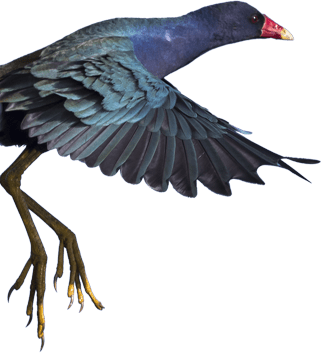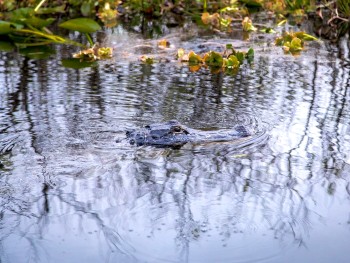[vc_row][vc_column][vc_column_text]
The best time to see alligators in the Everglades may be at sunset during the warm summer months of June through September though you may see them sunbathing on the riverbanks during October or November. A safari eco tour along the River of Grass in southwest Florida as birds of prey come alive, alligators and endangered sea turtles forage as water floods the riverbanks, and the panther prowls the vast subtropical mangrove and sawgrass wilderness of dirty brackish freshwater swamp bordered by silky fine grain sand is the best time to observe wildlife in their natural setting.
Foraging
A fierce predator, the American alligator eats fish, small mammals, birds, and reptiles found in marshes, rivers, and lakes throughout the southeastern United States. Glossy black cormorants dive under water for fish as a young alligator eats insects, frogs, and small fish growing one foot longer each year with even its skin color dependent on the habitat. Dense algae blooms tint alligator skin green or olive green, or tannic acid seeping into the water from trees and decaying leaves turn the reptile brown, black, or gray with a creamy abdomen.
Sheltering
Foraging activities stop at temperatures below 68 degrees Fahrenheit. An alligator burrows underground to shelter in dens as temperatures drop. The alligator hole retains water and attracts red-bellied sea turtles that hatch eggs in the gator’s den. Full-grown gators are 13 to 15 feet long, and mature females are from 6 to 10 feet long. The juvenile alligator shines with brilliant yellow bands that disappear with age.
Eco Tours from Fort Lauderdale
Millions of visitors enjoy boating through the large subtropical wilderness just south of Fort Lauderdale viewing tall slender pink flamingo, three to five feet tall, gracefully wading in freshwater marshes every year. You don’t have to be physically fit to enjoy our safari into the 1.5-million-acre wetland comprised of seven national parks. Our airboats are accessible by wheelchair and educational displays and films in the visitor’s centers prepare guests of all ages for the 60 to 90-minute trip. Rustic wilderness campsites, canoes, and kayaks are also available for adventurous seasoned campers, unafraid of mosquitoes and wildlife.
Once An Endangered Species
The alligator was removed from the endangered species list in 1987, and is no longer at risk of extinction. Poor quality habitats can endanger entire species of animals, but hunters trapping and shooting depleted the alligator population. The National Park Service, federal agencies, and nonprofit organizations strive to restore natural habitats, protect endangered species, and educate the public of the animal’s plight. Even an adult male alligator might eat a baby or juvenile alligator.
Alligator Attacks Are Rare
An alligator is an ectothermic, cold-blooded reptile whose body temperature drops with the ambient temperature. Alligator holes irrigate the landscape holding enough water for survival during brumation. Brumation is a state of dormancy not deep hibernation. The water in their holes benefits other wildlife though some unsuspecting creatures may sustain the drowsy dormant alligator. The Mangrove trees also store water in their roots thriving paradoxically in barren areas under scorching hot sun.
Don’t Feed the Wildlife
Visitors must never feed the wild carnivores or approach their occupied nests. An alligator has sharp crushing teeth close with thousands of pounds of pressure, and humans associated with food are at increased risk of attack.
University of Miami – Everglades National Park
The University of Miami conducted helicopter surveillance to locate and examine 849 alligator nests from 1985 to 1998. The number of nests annually varied from 18 or 23 to 40 or 47. Eggs hatched varied from 32% to 79% with eggs the remaining eggs flooded, preyed upon, or crushed. Six-foot females are most likely to reproduce. They build nest elevated three to four feet above ground and six to seven feet in diameter. The mother protects her eggs from predators and flood water for 58 to 63 days. Eggs incubated above 90 degrees Fahrenheit release male hatchlings, and eggs incubated below 86 degrees Fahrenheit release females.
Hatchlings
When she finally hears her hatchlings breaking out of their eggshells, the mother curls her tongue to hold her babies. She carries eight or ten at a time to the water in her tongue and shakes her head to drop the hatchlings into the water to swim. Hatchlings and juveniles stay under the watchful eyes of their collective mothers for one to three years as they grow to remain safe from adult males, raccoons, and birds.
The Comprehensive Everglades Restoration Program
The University of Miami mapped nest locations and also visited nests on foot to determine that at least 30% of the adult females nested every year, and more nests were built in wetter years than during droughts. During highwater years, 70%, or 233 out of 332 nests contained no eggs and 20% more eggs drowned killing the hatchling within. Of 760 to 1572 mature females, only 29 to 60% nested annually. Comprehensive restoration of the natural habitat through a series of man-made canals, locks, and levees helped the Florida alligator increase its numbers sufficiently to get off the endangered species list.
Airboat Eco Tours
Call or contact Airboat Eco Tours to reserve a place on one of our tours or reserve a charter boat for you and your family or friends. Your airboat eco tour is our family-owned and operated business. Our tour guides help you share the excitement of the naturalist examining rare plants and wildlife in their natural habitats. You’ll leave your memorable excursion with a greater appreciation of the delicate ecosystem of the alligator and his role in his or her dynamic ecosystem. The powerful quintessential alligator was dependent on human intervention for his or her survival. On our one, one and a half, or two-hour educational tour, you’ll ride on the wild side from the comfort and safety of your own seat.
[/vc_column_text][/vc_column][/vc_row]





